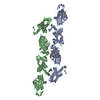+Search query
-Structure paper
| Title | Structural foundation for the role of enterococcal PrgB in conjugation, biofilm formation, and virulence. |
|---|---|
| Journal, issue, pages | Elife, Vol. 12, Year 2023 |
| Publish date | Oct 20, 2023 |
 Authors Authors | Wei-Sheng Sun / Lena Lassinantti / Michael Järvå / Andreas Schmitt / Josy Ter Beek / Ronnie P-A Berntsson /  |
| PubMed Abstract | Type 4 Secretion Systems are a main driver for the spread of antibiotic resistance genes and virulence factors in bacteria. In Gram-positives, these secretion systems often rely on surface adhesins ...Type 4 Secretion Systems are a main driver for the spread of antibiotic resistance genes and virulence factors in bacteria. In Gram-positives, these secretion systems often rely on surface adhesins to enhance cellular aggregation and mating-pair formation. One of the best studied adhesins is PrgB from the conjugative plasmid pCF10 of , which has been shown to play major roles in conjugation, biofilm formation, and importantly also in bacterial virulence. Since orthologs exist on a large number of conjugative plasmids in various different species, this makes PrgB a model protein for this widespread virulence factor. After characterizing the polymer adhesin domain of PrgB previously, we here report the structure for almost the entire remainder of PrgB, which reveals that PrgB contains four immunoglobulin (Ig)-like domains. Based on this new insight, we re-evaluate previously studied variants and present new in vivo data where specific domains or conserved residues have been removed. For the first time, we can show a decoupling of cellular aggregation from biofilm formation and conjugation in mutant phenotypes. Based on the presented data, we propose a new functional model to explain how PrgB mediates its different functions. We hypothesize that the Ig-like domains act as a rigid stalk that presents the polymer adhesin domain at the right distance from the cell wall. |
 External links External links |  Elife / Elife /  PubMed:37860966 / PubMed:37860966 /  PubMed Central PubMed Central |
| Methods | EM (single particle) / X-ray diffraction |
| Resolution | 1.84 - 11.0 Å |
| Structure data |  EMDB-16001: apo PrgB  EMDB-16002: PrgB bound to DNA  PDB-8beg: |
| Chemicals |  ChemComp-MG:  ChemComp-HOH: |
| Source |
|
 Keywords Keywords | CELL ADHESION / Ig-like domians |
 Movie
Movie Controller
Controller Structure viewers
Structure viewers About Yorodumi Papers
About Yorodumi Papers




